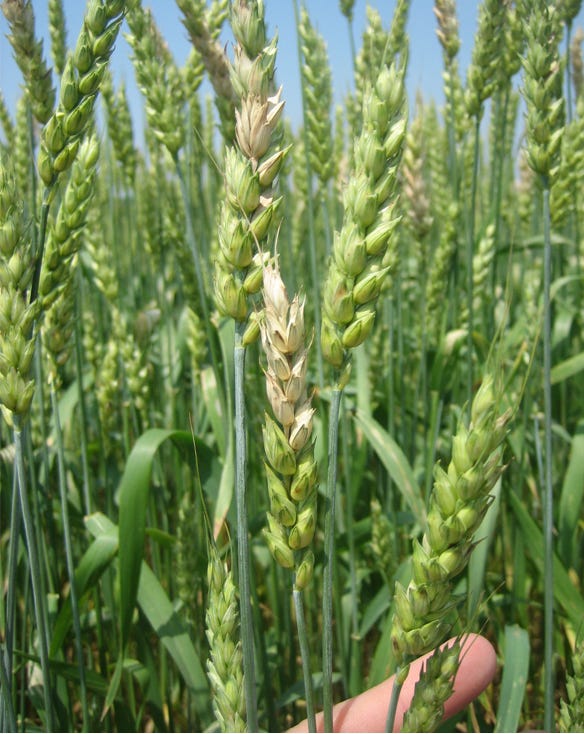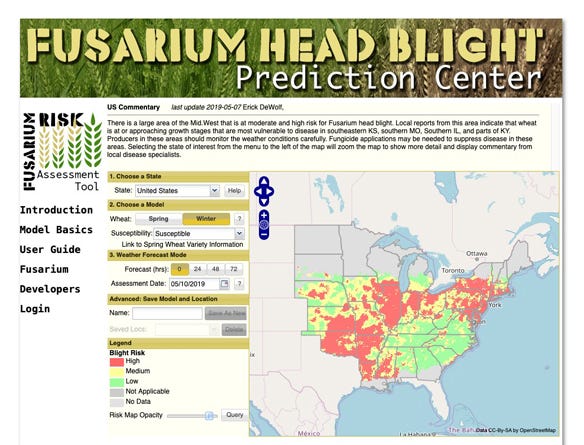
If you grow wheat, chances are it’s already flowering or is almost there. And with all the rain that has fallen as of late, the risk of fusarium head blight is high.
The Fusarium Head Blight Prediction Center, a consortium of Penn State, Ohio State, Kansas State and the U.S. Wheat and Barley Scab Initiative, has placed an entire swatch of the Midwest, Mid-Atlantic and Northeast under a high alert for fusarium head blight.
On her Twitter handle Thursday, Penn State plant pathologist Alyssa Collins told growers to be on alert and to start spraying for the fungus.
Wheat that is flowering now or in the next several days in southern PA should be sprayed for scab if at all possible! Keep track at https://t.co/0zhF4236aH pic.twitter.com/hZtoHbptbV
— Alyssa Collins (@PACropDoc) May 9, 2019
Caramba or Prosaro are the traditional fungicides used to prevent head scab in barley and wheat, but growers have a new weapon this year.
“A new fungicide, Miravis Ace (FRAC Group 3+7), has been labeled for the control of head scab in barley and wheat, and university trials have found it to provide disease suppression similar to existing products, but using a different chemistry,” Collins writes in an email. “This should help delay resistance to fungicides for this pathogen. Caramba or Prosaro are our traditional scab products and, along with Miravis Ace, also give good control of most leaf and head disease, in addition to suppressing scab.”
The most common species of head blight in wheat is Fusarium graminearum, which can also cause diseases in corn and grasses, according to Penn State Extension. The fungus survives in crop residues and is moved by rain or wind to wheat.
Wheat is most susceptible during flowering, when temperatures are between 65 and 86 degrees, and during moist conditions. She says the threat will remain so long as conditions are ripe for its formation.
Symptoms and spraying
Fusarium head blight will cause a tan or brown discoloration of the base of a floret within the spikelets of the head, according to Penn State Extension.
The spikelets will eventually become light tan or bleached in appearance.
“But as the wheat fills and before it ripens, evidence of infection can be found as bleached-out kernels,” Collins says. “This will happen somewhere between 18 and 21 days after flowering, depending on the weather.”
Infected kernels often look shriveled, white and chalky, and sometimes can develop a pink or red discoloration.
 BLEACHED WHEAT: Signs of fusarium head blight include bleached-out kernels, usually found 18 to 21 days after flowering.
BLEACHED WHEAT: Signs of fusarium head blight include bleached-out kernels, usually found 18 to 21 days after flowering.

She recommends that spray nozzles be angled 30 degrees down from horizontal toward the grain heads, and using forward- and backward-mounted nozzles, or nozzles with a two-directional spray, such as TwinJet nozzles.
Preventing mycotoxins
Fusarium head blight can produce deoxynivalenol, or DON, which at high amounts can be toxic to animals.
Collins says that high levels of scab don’t always result in high levels of toxin, but it should be an indicator that you should be prepared for it.
DON is likely present when harvested grains have high levels of tombstones or damaged kernels, according to Purdue Extension. Mycotoxin can accumulate until grain moistures fall below 13%.
The biggest risk to livestock is hogs. The Food and Drug Administration allows a maximum DON level in grain of 5 parts per million in hogs, 10 ppm in beef cattle and 10 ppm in poultry.
 BLIGHT HOT SPOTS: The Fusarium Head Blight Prediction Center uses an online map to show what places are at high risk for Fusarium head blight in wheat. Large areas of the Midwest, Mid-Atlantic and Northeast are in the “high risk” category.
BLIGHT HOT SPOTS: The Fusarium Head Blight Prediction Center uses an online map to show what places are at high risk for Fusarium head blight in wheat. Large areas of the Midwest, Mid-Atlantic and Northeast are in the “high risk” category.

Mycotoxin contamination is often highest in severely diseased kernels, according to Penn State Extension. Combines should be adjusted to blow out small, shriveled kernels to help reduce mycotoxins. Harvested grain should be dried to 13.5% moisture.
Grain suspected of being infected should be tested for DON and zearalenone.
About the Author(s)
You May Also Like






